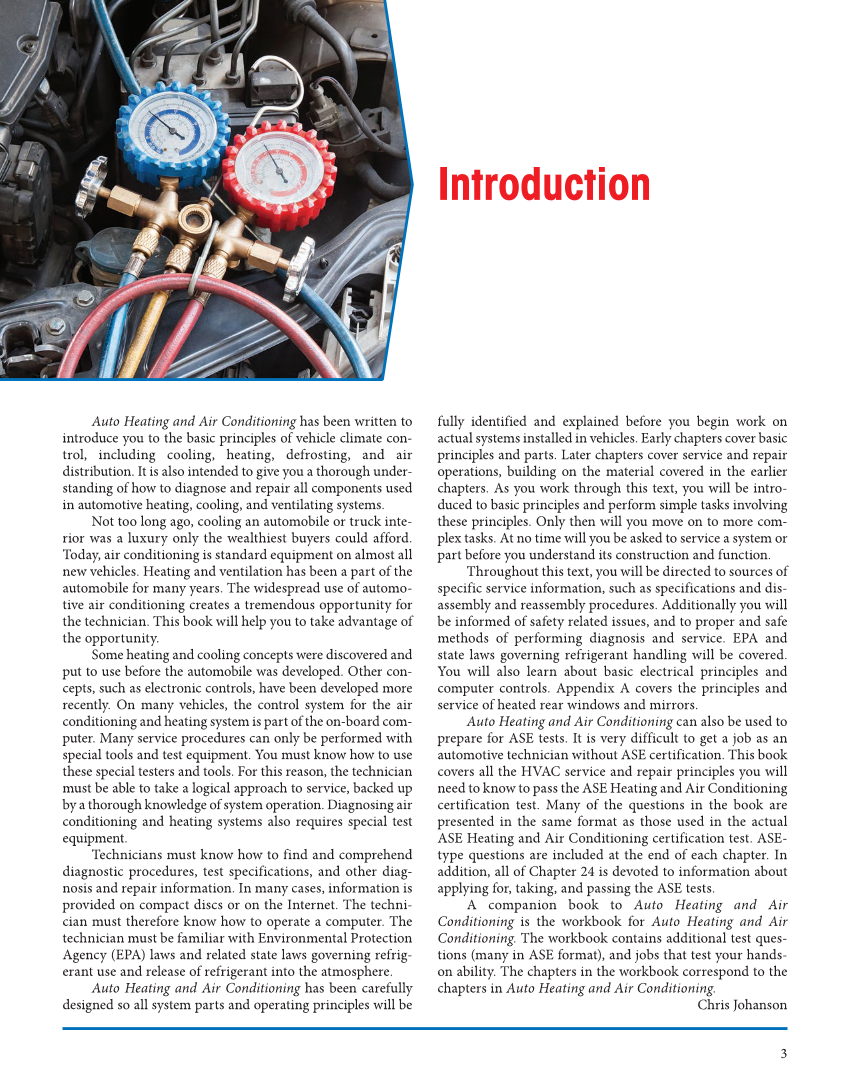Introduction Auto Heating and Air Conditioning has been written to introduce you to the basic principles of vehicle climate con- trol, including cooling, heating, defrosting, and air distribution. It is also intended to give you a thorough under- standing of how to diagnose and repair all components used in automotive heating, cooling, and ventilating systems. Not too long ago, cooling an automobile or truck inte- rior was a luxury only the wealthiest buyers could afford. Today, air conditioning is standard equipment on almost all new vehicles. Heating and ventilation has been a part of the automobile for many years. The widespread use of automo- tive air conditioning creates a tremendous opportunity for the technician. This book will help you to take advantage of the opportunity. Some heating and cooling concepts were discovered and put to use before the automobile was developed. Other con- cepts, such as electronic controls, have been developed more recently. On many vehicles, the control system for the air conditioning and heating system is part of the on-board com- puter. Many service procedures can only be performed with special tools and test equipment. You must know how to use these special testers and tools. For this reason, the technician must be able to take a logical approach to service, backed up by a thorough knowledge of system operation. Diagnosing air conditioning and heating systems also requires special test equipment. Technicians must know how to find and comprehend diagnostic procedures, test specifications, and other diag- nosis and repair information. In many cases, information is provided on compact discs or on the Internet. The techni- cian must therefore know how to operate a computer. The technician must be familiar with Environmental Protection Agency (EPA) laws and related state laws governing refrig- erant use and release of refrigerant into the atmosphere. Auto Heating and Air Conditioning has been carefully designed so all system parts and operating principles will be fully identified and explained before you begin work on actual systems installed in vehicles. Early chapters cover basic principles and parts. Later chapters cover service and repair operations, building on the material covered in the earlier chapters. As you work through this text, you will be intro- duced to basic principles and perform simple tasks involving these principles. Only then will you move on to more com- plex tasks. At no time will you be asked to service a system or part before you understand its construction and function. Throughout this text, you will be directed to sources of specific service information, such as specifications and dis- assembly and reassembly procedures. Additionally you will be informed of safety related issues, and to proper and safe methods of performing diagnosis and service. EPA and state laws governing refrigerant handling will be covered. You will also learn about basic electrical principles and computer controls. Appendix A covers the principles and service of heated rear windows and mirrors. Auto Heating and Air Conditioning can also be used to prepare for ASE tests. It is very difficult to get a job as an automotive technician without ASE certification. This book covers all the HVAC service and repair principles you will need to know to pass the ASE Heating and Air Conditioning certification test. Many of the questions in the book are presented in the same format as those used in the actual ASE Heating and Air Conditioning certification test. ASE- type questions are included at the end of each chapter. In addition, all of Chapter 24 is devoted to information about applying for, taking, and passing the ASE tests. A companion book to Auto Heating and Air Conditioning is the workbook for Auto Heating and Air Conditioning. The workbook contains additional test ques- tions (many in ASE format), and jobs that test your hands- on ability. The chapters in the workbook correspond to the chapters in Auto Heating and Air Conditioning. Chris Johanson 3
